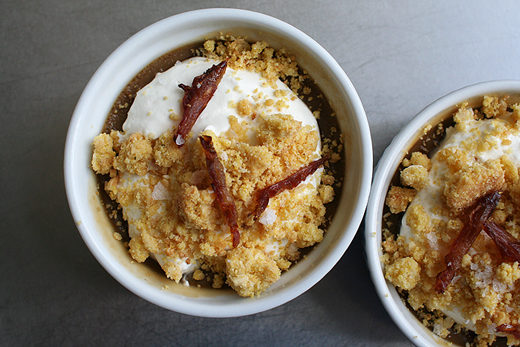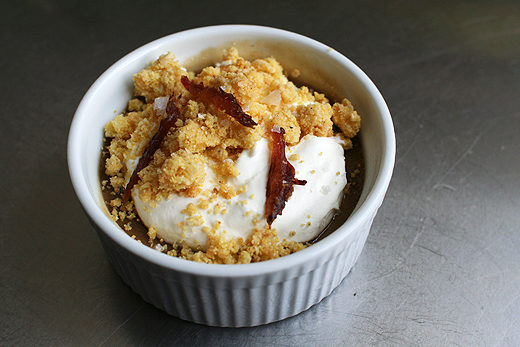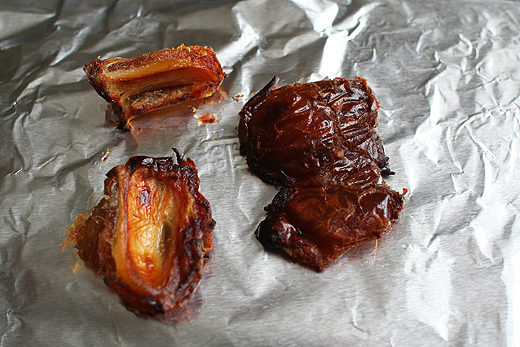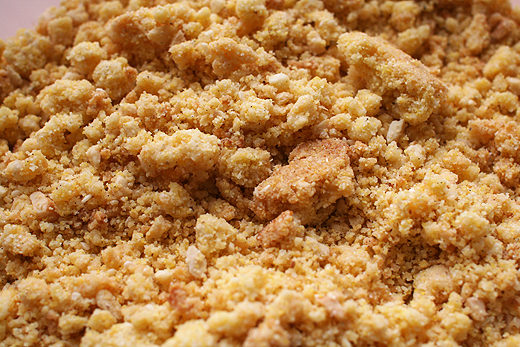
Amanda Rockman has left the building.
After a good run in Chicago, she has packed her bags and headed back home to Texas. You may remember Amanda from the famous Gateau Basque recipe she shared on these pages. If you’ve ever had the pleasure of eating a plate of sweets made by this super-talented chef, you probably won’t forget her. If pastry chefs were spirit animals, she’d probably be mine. So, as you might have guessed, I was a little bummed when I heard she was leaving town. So bummed that in her last couple of weeks I’d just show up at Nico and eat all of the desserts for dinner. Amanda’s been an important part of Chicago’s pastry scene for years—but Chicago’s loss is Austin’s gain (Austinites—Amanda will be in charge of all pastry at the soon to open South Congress Hotel, go tell her I said hello), and I am happy for Amanda and excited to see what she does next.

Before she left, Amanda kindly gifted us with one last recipe from her time in Chicago. This Butterscotch Bonet was on the last menu she designed for Nico Osteria. It is phenomenally good, like, Basque Cake Good. A bonet is an Italian pudding thickened with egg yolks, and no starch. It’s basically the best butterscotch pudding you’ll ever have. While there are a bunch of components to this recipe, none are particularly difficult and you can make them all in advance. You could also choose to simplify things if you like and serve the pudding with some unsweetened whipped cream and sea salt flakes. But I don’t go through the trouble of finding you recipes like this to have you take the easy way out—DO I?

Get thee a scale.
Butterscotch Bonet by Amanda Rockman
- 2 1/2 cups + 2 tablespoons heavy cream
- 2 1/4 ounces unsalted butter
- 246 grams dark brown sugar
- 3g salt
- 16g vanilla paste
- 12g amaro
- 135g egg yolks
Preheat oven to 350° F.
Heat the heavy cream to a simmer, and keep warm.
In a medium pot over medium-high heat, combine the butter and dark brown sugar and cook until sugar is melted and mixture is smooth. Reduce the heat to low and slowly add the hot cream to the sugar mixture, whisking as you pour the cream into the pot. Be careful! It will hiss and bubble and freak out. Once all of the cream is added whisk until all of the sugar is dissolved (some of the sugar may seize up when you add the hot cream and stick to the bottom edges of pan) and the mixture is smooth. Remove from the heat.
In a large heat-safe bowl, whisk the egg yolks to break them up. Starting with one ladleful of the hot butterscotch sauce, slowly whisk it into the egg yolks to temper them. Continue adding the butterscotch, a ladleful at a time, whisking constantly so that the eggs do not cook. Add the vanilla paste, salt, and amaro to the mixture and whisk to combine. Strain into a pitcher or a 4-cup pyrex measuring cup, to make it easier to pour.
Now, you’re going to have to do some figuring out here. You want a few oven-safe vessels to cook this in. They can be coffee or tea cups, ramekins, custard cups—whatever you have on hand. Ideally, they will all be the same size. The size of the cups, and how much you fill them will determine much of the rest of the recipe. I ended up filling 6 ramekins halfway full. Keep in mind that this is rich, and there are other components to the finished dessert. You’re going to set up a water bath for them to cook in using a large saucepan or a roasting pan. I like to line the bottom with a dish towel (it helps to prevent them from sliding around), and then set the filled ramekins on the dish towel. Slowly pour hot water into the roasting pan so that it goes halfway up the sides of the ramekins. Also, if you used a kitchen towel, make sure it is submerged in water. Cover the whole thing with aluminum foil and carefully transfer to the preheated oven. Cook until the puddings are set, but the centers still have some jiggle to them. I would start checking at 25 minutes. Mine took about 35 minutes to cook. Once they are set, remove the pan from the oven, remove the aluminum foil, and allow them to cool in the water bath. Once cool, cover the puddings with plastic wrap and transfer to the refrigerator to chill for at least an hour, or up to a couple of days.
When ready to serve, top each pudding with a small drizzle of date vinegar, some sbrisolona (see recipe below), a spoonful of unsweetened whipped cream (or a combo of cream and creme fraiche), some flaked salt and some caramelized dates (to caramelize dates I removed the pits from dates, rubbed them with coconut oil and broiled for a couple of minutes).

Sbrisolona (adapted slightly by Amanda Rockman from Brooks Headley)
- 233 grams all-purpose flour
233 grams instant polenta
150 grams sugar - 8 grams salt
8 grams baking powder
1 Egg
½ Vanilla bean, scraped
Zest from ½ lemon
Zest from ½ orange
233 grams unsalted butter, very cold - 15 grams toasted white sesame seeds
- 75 grams raw cashews, finely chopped
Preheat the oven to 350°F. Line a baking sheet with parchment or a Silpat and set aside.
In a medium bowl, combine the flour, polenta, sugar, salt, baking powder, egg, vanilla beans scrapings, lemon zest, and orange zest and mix by hand.
In a food processor, combine the butter and polenta mixture and pulse until the butter is pea size. Do not overpulse because you want there to be chunks of butter. (You can also do this part by hand, using a pastry cutter) Toss in the sesame seeds and cashews.
Sprinkle the mixture out into an even layer on the prepared baking sheet. Bake for 8-10 minutes, stir with a fork, and finish baking until lightly browned, about 12-20 minutes more.
Store in an airtight container for up to 2 weeks. The recipe makes a lot, but it is so delicious you’ll find yourself eating it on everything. On yogurt, as a healthy alternative to granola, for instance.

[Thanks, Amanda, for all of the inspiration and for always being willing to share. And thanks especially for allowing me to photoshop your face onto that cowgirl.]



Bryan says:
June 16th, 2015 at 9:53 am
I guess we’ll have to go see about this Austin place. Also, just to be clear, how does Basque Cake good compare with I’d Like to Thank the Academy good?
Tim says:
June 16th, 2015 at 11:25 am
Bryan- It’s even better. Let’s go to Austin.
Nancy in NJ says:
June 16th, 2015 at 11:40 am
This looks “be still my beating heart” good! I’ve been wanting to give Sbrisolona a whirl too. Any suggestions for a substitute for Amaro? Many thanks!
Louise says:
June 17th, 2015 at 5:29 am
I think it’s a fine excuse to go to Austin. Not that you needed an excuse.
Christina @ My Homespun Home says:
June 17th, 2015 at 12:01 pm
I was lucky enough to learn to make that basque cake when she taught it at the Peterson Garden Project. The cake obviously was amazing but the best part was really just learning from her, she was a great teacher. I’ve been thinking I need to attempt it at home.
Mary says:
June 18th, 2015 at 10:34 am
Super bummed that we lost such a talent–people of Austin, you’re in for a treat. Thanks for sharing this recipe with all of us.
Ava says:
July 13th, 2015 at 2:11 pm
Seriously, I am missing your posts! I decided to come visit and read about the butterscotch bonet Saturday night. Kismet! I was scheduled to meet friends for brunch and coffee at Nico. So when they brought the dessert menu over it was a no-brainer.
One od the best things I have eaten in a restaurant this year. Just exquisite! And I made my coffee date order it as her dessert as well. She is not normally a dessert eater and she agreed.
Thanks for this post and I hope you are well.
Wesley says:
November 29th, 2015 at 3:42 pm
Thank you so much for posting these amazing recipes! I am really excited to up my pastry skills. Also, just finally added a scale to my Christmas list, thanks to you.